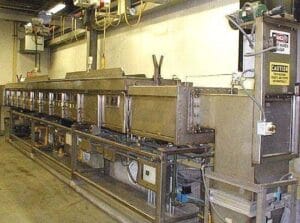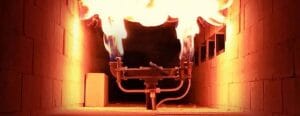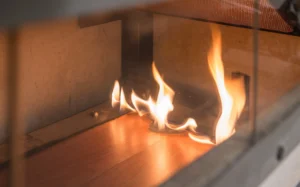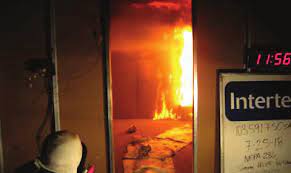Interior Finish Fire Testing
By Blog Author / July 19, 2024 / No Comments / Blog
Interior finish testing is a crucial aspect of building safety and compliance. With increasing emphasis on safety regulations, evaluating the resistance and performance of interior materials is essential. Fireproofing treatments play a vital role in slowing flame spread and minimizing the risk of property damage and injuries.
Fireproof interior finishes are designed to delay ignition and limit flame spread in an emergency. These materials undergo rigorous testing to assess performance under specific conditions, evaluating factors such as flame spread, smoke development, and heat release rate. By conducting these tests, manufacturers ensure their products meet essential safety standards.
The International Code Council states that “interior finish includes interior wall and ceiling finish and interior floor finish,” that “interior wall and ceiling finish” is “the exposed interior surfaces of buildings including, but not limited to: fixed or movable walls and partitions; columns; ceilings; and interior wainscoting, paneling, or other finish applied structurally or for decoration, acoustical correction, surface insulation, structural flame resistance, or similar purposes, but not including trim,” and that “interior floor finish” is “the exposed floor surfaces of buildings including coverings applied over a finished floor or stair, including risers.” Thus, when dealing with interior finish testing, a distinction needs to be drawn between walls (and ceilings) and floors.
The performance of interior wall and ceiling finishes is crucial in determining how a blaze develops. These materials contribute fuel and provide surfaces for flames to spread, transporting heat and smoke throughout a space or even into adjacent areas. Therefore, regulating their flame resistance is essential for safety.
steiner Tunnel Test

Figure 1
The Steiner tunnel test remains the standard method for evaluating surface flame spread and smoke development in interior finish materials. Developed by Al Steiner at Underwriters Laboratories in 1944 (Figure 1), it was originally designed for testing materials like wood and gypsum board. This test has since been standardized by major North American organizations (ASTM E-84, NFPA 255, UL 723, ULC S102) and is widely adopted in building and fire codes across the continent.
In the test, a specimen (7.3 m x 0.56 m, normally up to 0.15 m thick), either in one unbroken length or in separate sections joined end to end, is mounted face downwards so as to form the roof of a horizontal tunnel 305 mm high. The fire source, two gas burners, ignites the sample from below with an 89 kW intensity (Figure 2), and the combustion products are carried away by a controlled linear air velocity of 73 m/min (or, exactly, 240 ft/min). The normal output is a flame spread index (FSI) and a smoke-developed index (SDI). Flame spread is assessed visually by the progression of the flame front, while measurements of optical smoke density at the tunnel outlet determine the smoke obscuration. This information is used to plot time-based graphs of flame-spread distance and of optical density. FSI and SDI are then calculated based on the ratio between the areas under the curves for the material being tested and those for a cementitious board (assigned FSI and SDI values of 0) and for red oak flooring (assigned FSI and SDI values of 100).
Building, fire, and life safety codes (IBC, IFC, NFPA 5000, NFPA 101, and NFPA 1/UFC) classify interior wall and ceiling finishes into Class A (FSI ≤ 25; SDI ≤ 450), Class B (25 ≤ FSI ≤ 75; SDI ≤ 450), or Class C (75 ≤ FSI ≤ 200; SDI ≤ 450).

Figure 2
A major flaw in the Steiner tunnel test is that it does not produce results in engineering units. As a result, the data cannot be directly applied to fire hazard or risk analyses, limiting its usefulness beyond regulatory compliance.
This test continued to be popular when plastics started to be used in construction and in spite of the fact that the test is not always appropriate for every material. Samples that cannot be retained in place above the tunnel floor or which melt and continue burning on the tunnel floor (typical behavior for most thermoplastics) are still being tested with this equipment even though the results are not representative of the use of the material in realistic situations. The same can also be said about thin materials, which often give low FSI values mainly due to insufficient material in the test method to permit flame spread to be assessed properly. An understanding of some of these limitations has caused the codes to consider alternatives, either as replacements for the Steiner tunnel or as additional options (see section on heat release).
FLOOR FINISH TEST METHODS
Interior floor finishes face unique challenges compared to other finishes, as heat and smoke rise during a fire. Floor finishes may either ignite first or contribute additional fuel once the blaze spreads. Therefore, safety requirements focus on ensuring that floor finishes are difficult to ignite and do not facilitate the slow spread of flames to other compartments.
The Steiner tunnel cannot assess ignitability, and its fuel source is not appropriate to assess slow flame spread. Experience has shown that many flooring materials (traditional floor finishes such as wood flooring or resilient materials) will not ignite unless exposed to an ignition source of well over > 1 kW/m2, but that some carpet-like or loose-fill materials may ignite at such low heat fluxes. A study of precision of the flooring radiant panel test method found carpets with critical radiant heat fluxes well under 2 kW/m2.4
Therefore, all carpets and rugs sold in they United States must meet the “methenamine pill” test (ASTM D 2859), which ensures that flame spread will be minimal.

Figure 3
Most codes also regulate interior floor finish (in occupancies where combustion risks needs to be especially minimized) to be tested with the flooring radiant panel (ASTM E 648, NFPA 253, Figure 3) and require a “critical radiant flux” for ignition in excess of 4.5 kW/m2 (Class I) or 2.2 kW/m2 (Class II). In the flooring radiant panel, the floor finish (such as a carpet) is exposed to an incident heat flux from an angled gas-ignited radiant panel, with a maximum heat flux of approximately 11 kW/m2 at the farthest end from the igniter. The test method assesses the critical incident flux (which is measured by comparing the distance between the igniter and the point where flame propagation stops to a calibration curve) required for continued flame propagation.
This approach (even if it is based on old-fashioned tests) is quite suitable for interior floor finish. Some applications, typically in the transportation vehicle arena, also require flooring materials to meet one of a variety of smoke obscuration requirements, often based on a static smoke chamber box, either with a traditional radiant heater (ASTM E 662) or with a conical heater (ISO 5659-2, IMO Fire Test Procedures Code part 2, also known as ASTM E 1995 and NFPA 270).
OTHER TEST METHODS
The key question in any fire scenario is, “How big is the blaze?” The answer lies in the heat-release rate. A burning product can only spread flames to nearby materials if it generates enough heat to ignite them. Additionally, the heat must be released quickly enough to avoid being dissipated as it travels through the cooler surrounding air. Heat-release rate is the primary factor in fire hazard and is far more critical than ease of ignition, smoke toxicity, or flame spread in determining the time available for occupants to escape.

Figure 4
The above concepts are now applied to testing of interior (wall and ceiling) finish, and all U.S. codes use a room-corner test for the purpose. The use of the room-corner test can be an alternative to the Steiner tunnel test (for most interior finish materials) or the actual requirement (for foam plastic insulation and textile wall coverings). Thus, the building, NFPA Life Safety Codes allow most interior wall and ceiling finish materials to be tested using the NFPA 286 room-corner test (Figure 4) instead of the Steiner tunnel test, and the test results must then show that the test specimen does not cause flashover during the assessment and does not emit a total amount of smoke exceeding 1,000 m2. The total amount of smoke released is a measure of smoke obscuration (or smoke opacity) calculated as the integral, over time, of the smoke-release rate across the surface of the duct used for the measurement. Thus, the smoke release rate is measured in units of surface area over time and the total smoke released in units of surface area (such as m2).
Special interior finish ignition testing rules apply to some materials or products, as follows:
- Textile wall and ceiling covering materials are required to meet a Class A flame-spread index and smoke-developed index (using the Steiner tunnel test), and be used in a sprinklered environment or have passed a specific room corner test for textile wall coverings (NFPA 265, a less severe test and one where there are no smoke obscuration requirements), which requires that flashover not occur.
- Expanded vinyl wall coverings can be treated like textile wall coverings (see above) and like most other interior finish tested materials (use the Steiner tunnel or NFPA 286).
- Cellular or foamed plastic materials must always meet a Class B flame-spread index (using the Steiner tunnel test). They can be used as interior trim if the density of the material is high enough (> 320 kg/m3), and when used in that way, the amount of cellular foam is limited to 10% of the wall or ceiling. Alternatively, cellular or foamed plastic materials must meet the standard smoke obscuration requirement (smoke-developed index of <450, using the Steiner tunnel test) and must either be covered by a thermal barrier or meet a large-scale test that fully represents the hazard in the scenario in question. One of such tests is the NFPA 286 room-corner test.
ROOM-CORNER TEST
In the NFPA 286 room-corner test, three walls and the ceiling (or ceiling only, for interior ceiling finish) of a 2.4 m x 3.7 m x 2.4 m high room, with a standard-doorway, are lined with the material-to be tested. The ignition source is a gas burner placed in one corner (on the wall furthest from the doorway) flush against both walls that generates 40 kW for a 5-minute period, followed by 160 kW, for a further 10-minute period.
Heat release (based on the principle of oxygen consumption calorimetry) and smoke release are measured in the exhaust duct, and temperatures and heat fluxes are measured in the room.
The severity of the ignition source was designed to ensure that the gas burner flame alone reaches the ceiling, without contribution from the test material. Even though the test measures heat release, the codes simply require assessment of whether flashover occurs during the test, so much of the information collected during the test is not used.
Research was conducted to look into issues associated with room-corner testing. As a result, two additional important criteria required by the codes are that the flame spread does not reach any of the extremities of the test sample and that the total smoke release cannot exceed 1,000 m2 over the entire 15-minute test period.
If all criteria are met, the material is suitable for use in all applications where the codes require a material to be tested by the Steiner tunnel and where Class A, B, or C requirements exist. In practice, it is rare for a material to spread flame to the extremities of the test sample and still not cause flashover, since that would mean that the flame would reach the edge of the door and stop without exiting the doorway (one of the criteria for flashover). This means that any material that does not cause flashover and releases < 1,000 m2 of smoke is considered equivalent to a Class A material. In fact, it is likely that materials with very high heat-release rates (but not quite enough for flashover) should probably be classified separately from materials that have low peak rates of heat release rate.
NFPA 265 is a somewhat less severe variation of NFPA 286, which is applied exclusively to textile wall coverings (and expanded vinyl wall coverings). In NFPA 265 and NFPA 286, identical test rooms and identical gas burners are used. There are three main differences, however, in the ignition sources used for both tests: 1) in NFPA 265, the burner is placed 51 mm away from each of the walls, as opposed to flush against the walls as in NFPA 286 (but it is placed in the same corner as in NFPA 286); 2) in NFPA 265, after the first 5 minutes at 40 kW, the burner intensity is raised to 150 kW, as opposed to 160 kW in NFPA 286; and 3) smoke release measurements using NFPA 265 are not required in the codes. It is likely that, eventually, textile wall coverings will be required to be treated similarly to other interior finish.
ANALYSIS OF TEST METHODS
Now that the actual tests used have been presented, it is important to discuss the validity of the test methods and whether improvements should be put in place. One obvious improvement which would permit a much more logical approach to using fire safety engineering methods would be to apply a test method based on heat release for testing interior floor finish (such as the cone calorimeter, a bench-scale test, e.g., for example, ASTM E 1354, NFPA 271, ISO 5660).
In fact, two ASTM guides and one NFPA guide addressing hazard assessment, ASTM E 2280 (for healthcare occupancies), ASTM E 2067 (for rail cars), and NFPA 555 (on potential for flashover), all recommend the use of the cone calorimeter to assess heat and smoke release of interior floor finish, at incident heat fluxes of 25-30 kW/m2. However, it is true that the combination of the methenamine pill test and the flooring radiant panel test is sufficient to eliminate the vast majority of “bad actors.” Thus, the methods being used are fairly adequate for a prescriptive safety approach that does not discriminate against materials. The additional smoke release testing (used mostly in transportation environments) is not of very high value, but it may serve to eliminate some poor performing materials.
There continues to be controversy with regard to smoke release testing of interior wall and ceiling finish. In a field that continues to be dominated by the Steiner tunnel test (despite its well-known inadequacies for testing some materials) the question arises: Is it necessary to test for smoke release in the room-corner test, or is it enough to just develop low heat release products?
Five series of tests conducted in room-corner tests, systematically some 10% of the materials (10 of the 84) give low heat release but unacceptably high smoke release. So the importance of assessing smoke release of interior wall and ceiling finish in a largescale test is clear. Code writers then saw that both flame spread and smoke release (or heat release and smoke release) must be assessed to adequately regulate the performance of interior wall and ceiling finish materials, whatever test method is used.
Thus, a smoke-release criterion needed to be added to testing using the room-corner test (such as NFPA 286), for which heat release only used to be measured, while both flame spread and smoke release have always been required in the Steiner tunnel test. This problem can be resolved (and has now made its way into codes) by using equivalent criteria in both tests, since materials with very high smoke-developed index (SDI) are also likely to have a very high total smoke release (TSR) in the room-corner test, which is how the 1,000 m2 pass-fail criterion was developed.
In light of steady research, it becomes clear that for all of its traditional merits, the approach of codes to testing interior wall and ceiling finish is a slightly flawed concept. Clearly the room-corner test is a much more accurate way of assessing performance than the Steiner tunnel test. However, the codes allow the NFPA 286 room-corner test results based on the premise that materials that do not cause flashover (or high smoke release) in the room-corner test are known to also have flame spread indices of < 200 and smoke developed indices of less than 450 in the Steiner tunnel test.
These provisions work well to a point but need refinement. The Steiner tunnel test is likely to give falsely favorable results (in fact, this happens often with materials that melt and drip and with materials that are thin films) but it rarely gives falsely unfavorable results (meaning that a high flame-spread index, or FSI, is almost always indicative of a material with mediocre or poor performance).
The room-corner test results are potentially much more suitable to classification of materials, because the heat release rate history is obtained in the test. However, the fact that the heat release rate history is not used for code classification purposes results in some inconsistencies occurring when comparing results from both tests. Therefore, it would be important to use the heat release rate history in the roomcorner test in conjunction with testing whether flashover does or does not occur.
A comparative performance of 25 materials tested in the Steiner tunnel and in the room-corner, and illustrates the problem:
- 5 materials had an FSI of 200 or less (i.e., Class A, B, or C) in the Steiner tunnel but caused flashover in the room-corner test. The Steiner tunnel test classifies them as acceptable and the room corner-test as unacceptable.
- 14 materials had an FSI of 25 or less (i.e., Class A) in the Steiner tunnel and released less than 400 kW in the room-corner test. Both tests classify them as Class A.
- 2 materials had an FSI of > 25 and < 75 (i.e., Class B) in the Steiner tunnel and released less than 400 kW in the room-corner test. The Steiner tunnel test classifies them as Class B and the room-corner test as Class A.
- 2 materials had an FSI of 25 or less (i.e., Class A) in the Steiner tunnel and released more than 400 kW but did not cause flashover in the room-corner test. Both tests classify them as Class A.
- 2 materials had an FSI of 200 or less (i.e., Class C) in the Steiner tunnel and almost caused flashover in the room-corner test. The Steiner tunnel test classifies them as Class C and the room-corner test as Class A.
In conclusion, fire testing of interior finish is probably adequate to eliminate the poorest performers (both in terms of heat release, or flame spread, and smoke release). However, in terms of maximizing the usefulness of current research and to accommodate modern building materials, the Steiner tunnel test falls short. In applying a variety of new and specific tests, the full capabilities of the room-corner test, including the actual heat release rates measured, could be incorporated into engineering, and improvements in that area would be welcome.
